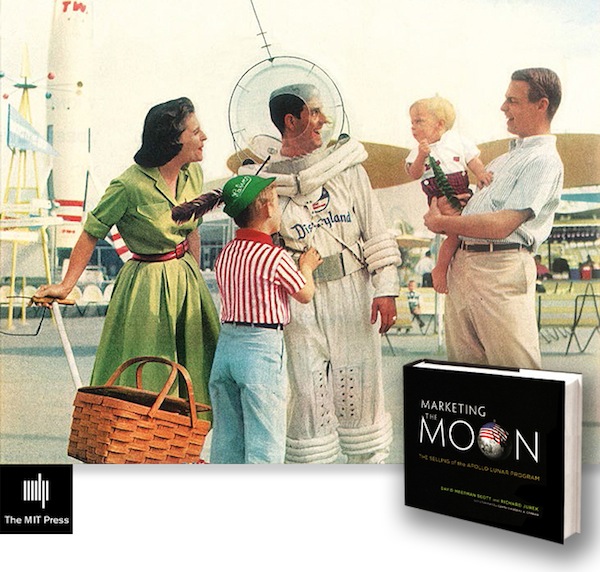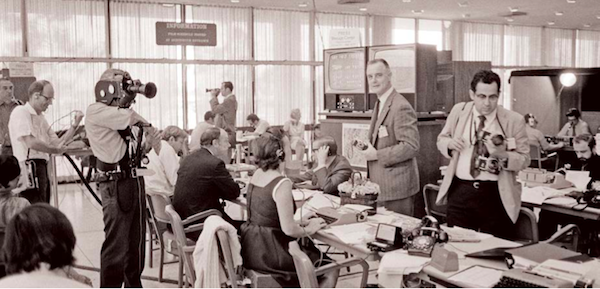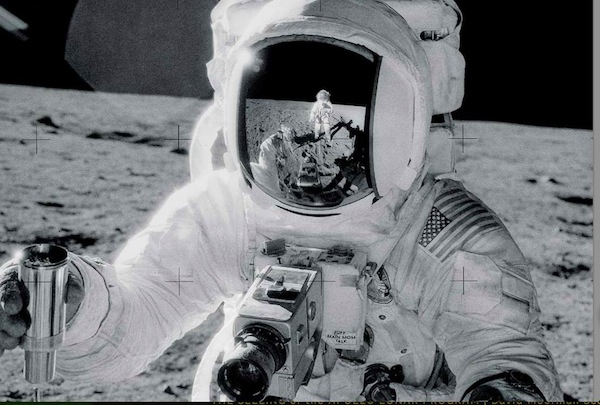Content marketing is all the rage today, but did you know the greatest marketing case study in human history actually occurred in the late 1960s and early 1970s?
It began with President John F. Kennedy standing before Congress in 1961 and made it a goal to put a man on the moon before the decade was over. The end result was the historic landing of Apollo 11.
“It’s actually the greatest story never told (until now) about content as a marketing tool that helped to deliver humans to the moon,” said David Meerman Scott, most notable for writing The New Rules of Marketing and PR and coining the term newsjacking. He has just released his latest book: “Marketing the Moon: The Selling of the Apollo Lunar Program”.

Marketing Space for the United States
 A departure from his usual social media and digital flight pattern, Scott’s “Marketing the Moon” tells the story of how NASA not only put the first man on the moon, but pioneered the use of brand journalism, product placement, and real-time storytelling with the epitome of transparency and authenticity.
A departure from his usual social media and digital flight pattern, Scott’s “Marketing the Moon” tells the story of how NASA not only put the first man on the moon, but pioneered the use of brand journalism, product placement, and real-time storytelling with the epitome of transparency and authenticity.
For the space enthusiasts and sci-fi cult-followers who create and follow the GIFs and memes branded with “Star Wars”, “Space Odyssey”, and “Star Trek”, “Marketing the Moon” captures the challenges and the ultimate success of marketing one of the greatest achievements in American history as noted in the foreword written by Captain Eugene A. Cernan, the NASA astronaut who became the 11th person to walk on the Moon and “the last man on the Moon”.
Scott wrote “Marketing the Moon” with Richard Jurek, president of Inland Marketing & Communications. They share the lifelong passion of being enthusiasts and collectors of historic space artifacts from the Apollo program. It was that passion and collective dedication that allowed them to take this opportunity to curate the historical data in a time-capsule-like book filled with nostalgic marketing memorabilia.
“It’s been a blast to dig into marketing history by speaking with half the men who walked on the moon, NASA public affairs staff, the PR people from contractors like Boeing and Raytheon, and journalists from publications like The New York Post and Reuters – part of the hundreds and thousands of unsung participants from the golden age of spaceflight,” Scott said.
8 Lessons for Modern Marketers From ‘Marketing the Moon’
What’s old is new and improved. Content marketing is nothing new, but its recent popularity surge has marketers scrambling to get it right or crash and burn.
“Many marketers are over the moon about the ‘new’ concept of content marketing as a key component to SEO, few realize that content marketing has been around for 50 years in an offline world,” said Scott who attended his first Search Engine Strategies conference in 2002 and was a keynote speaker at SES New York in 2010.
“Fundamentals are important so looking back informs us how to go forward. While everybody is looking for the next big thing, I found inspiration by going back half a century,” Scott said.

- Teach your PR and content marketing department to work as reporters, act like journalists. This is NASA’s content marketing approach to PR. In practice, Public Information Office staff worked as reporters within the agency, seeking out newsworthy information from NASA technical personnel and processing it into a form useful to the press.
- Hire former journalists who are good writers and understand the news business. Walter T. Bonney, the head of NASA’s nascent Public Information Office made it his business that NASA’s public affairs group did not act as pitchmen, but as reporters. Bonney, a former journalist, actively sought and recruited staff with print and broadcast media experience. Among those Bonney enlisted during the early days of the agency were Paul Haney and Jack King, who would soon play key roles during the Apollo program. “The core contingent of NASA Public Affairs people—just about all of us—were ex-newsmen,” King told Scott in a lengthy interview. “We were good writers, and we knew the news business. That made a major difference in the whole operation.”
- Create materials and content that address the needs of your audience. The NASA Public Affairs Office’s growing ranks of journalists understood what constituted a good story and what details appealed to the press. Thus, NASA created materials that addressed reporters’ needs in press releases, bylined articles, background materials, and in sponsored media symposiums, television newsreels, and fully produced radio broadcasts complete with interviews and sound effects. This content output helped to feed a world hungry for information about America’s space efforts, and leave the world’s press outlets receptive and clamoring for content to serve up to their audiences.
- Awesome content lasts forever and is what creates history. Content was not only king during Apollo, it was also one of the earliest successful brand journalism campaigns in history, Scott said.
- Learning as you go pays off; with risk comes great rewards. Don’t think for a moment that NASA masterminded a PR campaign that brought the Apollo missions into our living rooms. Just like everything else about the Moon program, how – and how much – to share Apollo with the public was a learn-as-you-go affair that involved not only NASA’s Public Affairs Office but also top NASA managers and even astronauts said Andrew Chaikin, author of “A Man on the Moon” in his “Marketing the Moon” review.
- Transparency and authenticity still wins. Even for Neil Armstrong, the first man to step onto the surface of the moon, NASA did not script his famous words, or give him any direction on what to say – during arguably one of the most watched global television events in history NASA gave him the personal freedom, as they did for all the other astronauts, to make his own statements and speak his own mind.
- Brand journalism orbits content marketing yesterday and today. NASA didn’t have a massive PR machine that worked to shape the global press image of the astronauts and the program. Staffed largely by professional journalists, the NASA Public Affairs Office operated more like a newsroom to rapidly disseminate information to the world press. More than 3,000 reporters covered the Apollo 11 mission from the Cape and Houston, while many thousands around the world worked from home.
- Reporting versus selling. NASA was not “spinning” or “selling” the space program, but reporting it in a remarkably open way, in as close to real time as the technology of the time allowed, said Scott.
5 Things Digital Marketers Need to Think About in 2014

- Real-time mindset. The real-time mindset recognizes the importance of speed. It is an attitude to business (and to life) that emphasizes moving quickly when the time is right.
- Get the big idea of newsjacking. The art of injecting your Ideas into a breaking news story to generate tons of links is an amazing strategy. But it requires real time.
- Incredible (and credible) content. Doing SEO on a crappy site makes it slightly less crappy. You need to start with great content.
- Write like a human, not a Martian. Cutting-edge, mission-critical, innovative, best-of-breed gobbledygook words and phrases suck for SEO. Write like humans talk.
- Create brand evangelists. Getting people to come to your site is only the beginning. Make it compelling for them to stay.
Summary
The world watched the first man walk on the moon thanks to NASA’s pioneering brand journalism finding a voice. Today, NASA astronauts carry the torch by live tweeting from space.
“Marketing the Moon” shares the most successful marketing and public relations campaign in history, featuring heroic astronauts, press-savvy rocket scientists, enthusiastic reporters, deep-pocketed defense contractors, and the ingenuity of brand sponsorships like Tang and the brand relations of Disneyland’s Tomorrowland.
One small step for brands, one giant leap for brand kind.
Image credits: Marketing the Moon

 A departure from his usual social media and digital flight pattern, Scott’s “Marketing the Moon” tells the story of how NASA not only put the first man on the moon, but pioneered the use of brand journalism, product placement, and real-time storytelling with the epitome of transparency and authenticity.
A departure from his usual social media and digital flight pattern, Scott’s “Marketing the Moon” tells the story of how NASA not only put the first man on the moon, but pioneered the use of brand journalism, product placement, and real-time storytelling with the epitome of transparency and authenticity.
